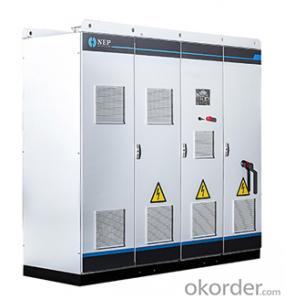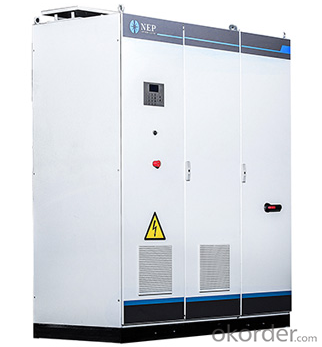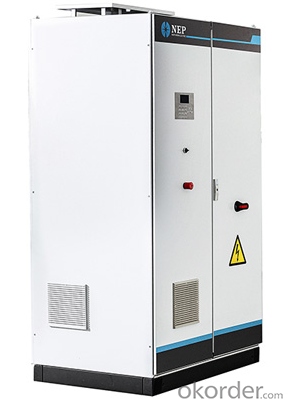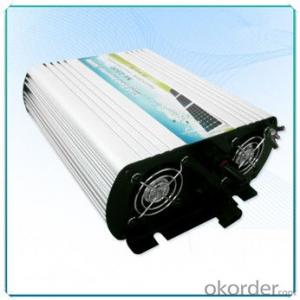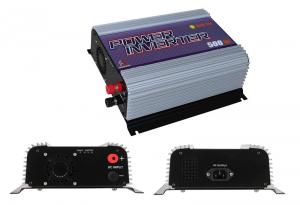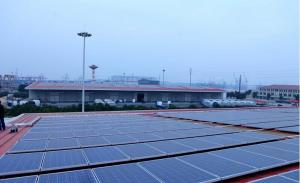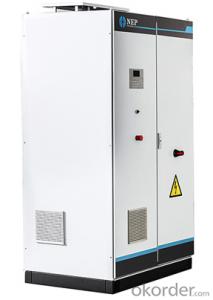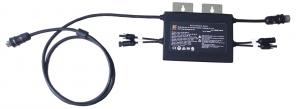500kW Grid Tied Solar Inverter BDE-500N
- Loading Port:
- Qingdao
- Payment Terms:
- TT OR LC
- Min Order Qty:
- 10 unit
- Supply Capability:
- 1000 unit/month
OKorder Service Pledge
OKorder Financial Service
You Might Also Like
Description:
A solar micro-inverter, converts direct current (DC) electricity from a single solar panel to alternating current (AC). The electric power from several micro-inverters is combined and fed into an existing electrical grid. Micro-inverters contrast with conventional string or central inverter devices, which are connected to multiple solar panels.
Characteristic & Advantages:
More Energy Harvest: Distributed MPPT allows10~25% more energy harvest
Simple: Modularized,single ac cable to the house
Reliability: Longer life time and almost 100% operation hours
Security: No high Voltage, makes safter environments
Inteligent : Monitoring each module
Savings: No dc components and significantly save labor cost
BDE-500N
★ Advanced digital control techniques using the latest DSP Optimized anti-islanding technique for the highest system reliability.
★Optimized Maximum Power Point Tracking technique guarantees the maximum power output from the PV array User oriented Graphic User Interface (GUI) on an integrated.
★ 128*64 graphic VFD and a keypad panel..
★Support multiple communication protocols, including RS232/RS485/Ethernet/Zigbee etc.
★ Complete protection functions to protect against reverse DC polarity,over temperature,over current,short cirucuit,over/under voltage,anti-islanding,etc.
★ Can be used at a wide range of environment temperatures and high altitude.
★ Automatically power-on in the morning and enter a low power mode at night. No local operators required for daily operation
- Q: Can a solar inverter be used in areas with high humidity and salt air exposure?
- Certainly, a solar inverter can indeed be utilized in regions characterized by elevated humidity levels and salt air exposure. Nevertheless, it is imperative to opt for a solar inverter explicitly engineered to withstand such circumstances. The presence of high humidity has the potential to induce corrosion and harm electronic components, while salt air exposure can expedite corrosion due to the corrosive properties of salt. Consequently, it is vital to choose an inverter constructed from corrosion-resistant materials, such as stainless steel or coated circuit boards. Furthermore, consistent maintenance and cleaning of the inverter are essential to guarantee optimal performance and longevity in such environments.
- Q: What is the role of a solar inverter in voltage support?
- The role of a solar inverter in voltage support is to convert the direct current (DC) produced by solar panels into alternating current (AC) that can be used by the electrical grid. Additionally, it helps regulate and stabilize the voltage levels, ensuring that the electricity generated from solar power is compatible with the grid's voltage requirements.
- Q: How does a solar inverter handle ground fault protection?
- A solar inverter handles ground fault protection by continuously monitoring the flow of current between the solar panels and the ground. If it detects any abnormal current leakage, indicating a ground fault, it quickly shuts down the system to prevent any safety hazards or damage to the equipment.
- Q: How do you choose the right size solar inverter for your system?
- To choose the right size solar inverter for your system, you need to consider the total power output of your solar panels and the maximum power rating of the inverter. It is important to match the inverter's capacity with the maximum power output of your solar panels to ensure optimal performance and efficiency. Additionally, factors such as the type of system (off-grid or grid-tied) and future expansion plans should also be taken into account when determining the appropriate size of the solar inverter for your system.
- Q: What are the common troubleshooting steps for a malfunctioning solar inverter?
- The common troubleshooting steps for a malfunctioning solar inverter may include checking the power supply, inspecting the wiring connections, resetting the inverter, performing a firmware update, checking for error codes or error messages, and consulting the manufacturer's manual or contacting technical support for further assistance.
- Q: What is the maximum output power of a solar inverter?
- The maximum output power of a solar inverter depends on its size and specifications. Typical residential solar inverters have a maximum output power ranging from 1 kilowatt (kW) to 10 kW, while commercial and utility-scale inverters can reach several megawatts (MW) of power output.
- Q: Can a solar inverter be used with different types of tracking algorithms?
- Yes, a solar inverter can generally be used with different types of tracking algorithms. Solar inverters are designed to convert the direct current (DC) generated by solar panels into alternating current (AC) for use in homes or businesses. The tracking algorithms, such as single-axis or dual-axis tracking, are responsible for optimizing the output of solar panels by adjusting their tilt and orientation according to the sun's position. Solar inverters are typically compatible with various tracking algorithms, allowing flexibility in system design and maximizing energy generation.
- Q: What is the role of a power monitoring feature in a solar inverter?
- The role of a power monitoring feature in a solar inverter is to constantly monitor and measure the amount of power being generated by the solar panels. This feature allows users to track the performance of their solar system, detect any issues or malfunctions, and optimize the energy output for maximum efficiency. It provides real-time data on the power production, enabling users to make informed decisions regarding energy usage and grid integration.
- Q: Can a solar inverter be used with solar-powered water purification systems?
- Yes, a solar inverter can be used with solar-powered water purification systems. A solar inverter is responsible for converting the direct current (DC) produced by solar panels into alternating current (AC) for powering electrical devices. In the case of solar-powered water purification systems, the solar panels generate electricity, which is then converted by the inverter to power the system's pumps, filters, and other components required for water purification.
- Q: How does a solar inverter handle voltage rise in case of low load conditions?
- A solar inverter handles voltage rise in case of low load conditions by reducing the power output from the solar panels. It does this by adjusting the voltage and frequency of the electricity generated, ensuring that the voltage remains within the acceptable range. This prevents any damage to the inverter or connected devices and ensures the efficient operation of the solar system.
Send your message to us
500kW Grid Tied Solar Inverter BDE-500N
- Loading Port:
- Qingdao
- Payment Terms:
- TT OR LC
- Min Order Qty:
- 10 unit
- Supply Capability:
- 1000 unit/month
OKorder Service Pledge
OKorder Financial Service
Similar products
Hot products
Hot Searches
Related keywords
